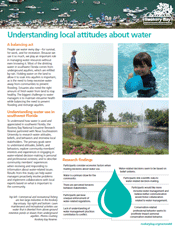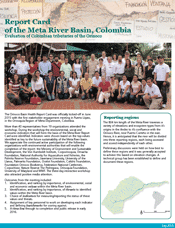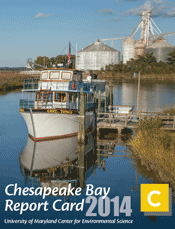Video & Blog Highlights
Video
- Caroline Donovan presented the latest Science for Citizens seminar titled "UMCES Chesapeake Bay Report Card- the 2014 Results" which is now posted to IAN's website and on YouTube.
Blog
- Mid-Atlantic Volunteer Monitoring Conference
- Bita River Report Card Workshop- The Orinoco River Basin, Colombia
- Building coastal resilience through stories
Restoring the Rookery Bay factsheets
 IAN, in collaboration with the Rookery Bay National Estuarine Research Reserve, produced a series of fact sheets highlighting research completed as part of the Restoring the Rookery Bay Estuary Project. Over the past five years, the Restoring the Rookery Bay Estuary Project has focused on collaborative watershed management through hydrologic, ecologic, and social science research, education, and partnerships. This series of newsletters aids stakeholders and managers in understanding the hydrology, fisheries, aquatic habitat, and human attitudes surrounding the Rookery Bay Estuary, to inform management decisions within the Rookery Bay National Estuarine Research Reserve.
IAN, in collaboration with the Rookery Bay National Estuarine Research Reserve, produced a series of fact sheets highlighting research completed as part of the Restoring the Rookery Bay Estuary Project. Over the past five years, the Restoring the Rookery Bay Estuary Project has focused on collaborative watershed management through hydrologic, ecologic, and social science research, education, and partnerships. This series of newsletters aids stakeholders and managers in understanding the hydrology, fisheries, aquatic habitat, and human attitudes surrounding the Rookery Bay Estuary, to inform management decisions within the Rookery Bay National Estuarine Research Reserve.
Meta River Workshop newsletter
 The Meta River Report Card Workshop newsletter, released in both English and Spanish, summarizes the outcomes from the report card workshop that took place in Puerto Lopez, Colombia. Values, threats, and indicators were the key items determined during the three day workshop. We also established a technical working group to develop the indicator thresholds and scoring, along with a timeline for release of the report card. IAN is developing report cards for three tributaries of the Orinoco River in Colombia.
The Meta River Report Card Workshop newsletter, released in both English and Spanish, summarizes the outcomes from the report card workshop that took place in Puerto Lopez, Colombia. Values, threats, and indicators were the key items determined during the three day workshop. We also established a technical working group to develop the indicator thresholds and scoring, along with a timeline for release of the report card. IAN is developing report cards for three tributaries of the Orinoco River in Colombia.
Chesapeake Bay health improved in 2014
 Strong improvements were seen in 2014 Bay health as almost all indicator scores improved. Overall, Chesapeake Bay scored 50%, up from the previous year's score of 45% (both C's). While the improvements are promising, most regions still have poor to moderate scores. The highest scoring indicator was dissolved oxygen (89%, an A), and the lowest scoring indicator was water clarity (15%, an F). Aquatic grass scores improved or stayed the same in all regions, due to the expansion of Ruppia. Both nitrogen and phosphorus are showing significantly improving trends over time, while chlorophyll a and water clarity have declining trends. This report card includes an analysis on the resiliency of coastal wetlands to current and future sea level rise rates as part of a Climate Change Resilience Index study. For further details, visit the Report Card website.
Strong improvements were seen in 2014 Bay health as almost all indicator scores improved. Overall, Chesapeake Bay scored 50%, up from the previous year's score of 45% (both C's). While the improvements are promising, most regions still have poor to moderate scores. The highest scoring indicator was dissolved oxygen (89%, an A), and the lowest scoring indicator was water clarity (15%, an F). Aquatic grass scores improved or stayed the same in all regions, due to the expansion of Ruppia. Both nitrogen and phosphorus are showing significantly improving trends over time, while chlorophyll a and water clarity have declining trends. This report card includes an analysis on the resiliency of coastal wetlands to current and future sea level rise rates as part of a Climate Change Resilience Index study. For further details, visit the Report Card website.
Worldwide WWF-IAN partnership launches in Stockholm
 The partnership between WWF and IAN/UMCES was officially launched at World Water Week in Stockholm, Sweden in late August 2015. Simon Costanzo represented IAN at the event which was very well attended and marketed as "Get the Grade". This new partnership aims to widen the audience and uptake of report cards as an environmental management tool for river basins around the world.
The partnership between WWF and IAN/UMCES was officially launched at World Water Week in Stockholm, Sweden in late August 2015. Simon Costanzo represented IAN at the event which was very well attended and marketed as "Get the Grade". This new partnership aims to widen the audience and uptake of report cards as an environmental management tool for river basins around the world.
On the Horizon...
- Visit the IAN team at the Horn Point Lab Open House October 10, 2015 in Cambridge, MD.
- IAN's Annapolis office will host this year's MEES Colloquium 30-31 October 2015. You can register for the event here.
- IAN staff will be conducting a session at the annual Coastal & Estuarine Research Federation conference held in Portland, OR November 2015.